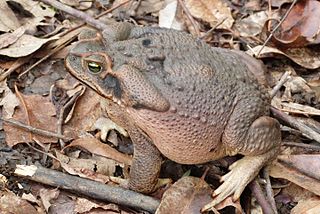Atelopus nicefori is a species of toad in the family Bufonidae. It is endemic to Colombia. Its natural habitats are subtropical or tropical moist montane forests and rivers. It is threatened by habitat loss.

Rhinella achalensis is a species of toad in the family Bufonidae that is endemic to northern Argentina.
Rhinella acutirostris is a species of toad in the family Bufonidae. It is found in Brazil, Colombia, Panama, and Venezuela. Its natural habitats are subtropical or tropical moist lowland forests, freshwater marshes, and intermittent freshwater marshes.
Rhinella amboroensis is a species of toad in the family Bufonidae that is endemic to the region of its type locality in the Carrasco Province of Bolivia and the adjacent Santa Cruz Department. Its common name is Cochabamba toad. It may exist in the Carrasco National Park and/or Amboró National Park, depending on its exact range.

Rhinella crucifer is a species of toad in the family Bufonidae. It endemic to Brazil and known from the Atlantic Forest of eastern Brazil between the states of Ceará in the north and Rio de Janeiro in the south. Common name striped toad has been coined for it. "Rhinella pombali" is a hybrid between Rhinella ornata and this species.

Rhinella diptycha, sometimes referred to as Cope's toad, Schneider's toad, cururu toad, or rococo toad, is a toad found in northern Argentina, Paraguay, Uruguay, eastern Bolivia, and eastern and southern Brazil. It is one of three rather similar species sometimes referred to as "cururu toads" in Brazil, the others being R. jimi and R. marina. Like those, R. diptycha is a large toad, females up to 25 cm (9.8 in) in snout–to–vent length and males up to 18 cm (7.1 in).
Rhinella fissipes, the Carabaya toad, is a species of toad in the family Bufonidae that is found in Bolivia and Peru. Its natural habitats are subtropical or tropical moist montane forests, rivers, freshwater marshes, and intermittent freshwater marshes.

Rhinella granulosa, also known as granular toad and common lesser toad, is a species of toad in the family Bufonidae. The species was redelimited in 2009 and is now considered endemic to Brazil.
Rhinella iserni, also known as the Rio Perene toad, is a species of toad in the family Bufonidae. It is endemic to Peru and is known from the Andean valleys of Chanchamayo and Perené Rivers in the Junín Region. It inhabits montane tropical forest. However, precise habitat data, including altitude, are lacking. It could not be found in surveys conducted in 2014. Threats to this species are not known. It might be present in Pui Pui Protection Forest or San Matías–San Carlos Protection Forest.
Rhinella justinianoi is a species of toad in the family Bufonidae that is endemic to Bolivia. Its natural habitats are subtropical or tropical moist montane forests and rivers. It is threatened by habitat loss.
Rhinella nesiotes is a species of toad in the family Bufonidae that is endemic to Peru. Its natural habitats are subtropical or tropical moist lowland forests and subtropical or tropical moist montane forests. It is threatened by habitat loss.

Rhinella ornata is a species of toad in the family Bufonidae that is found in Brazil and possibly Argentina. Its natural habitats are subtropical or tropical moist lowland forests, rivers, and intermittent freshwater lakes. It is threatened by habitat loss.
Rhinella rubropunctata is a species of toad in the family Bufonidae that is found in southern Chile and Argentina. Its natural habitats are humid to xeric temperate forests and open environments. It tolerates a certain degree of disturbance. Breeding takes place in shallow temporary ponds near rivers, reservoirs and lakes. It is threatened by habitat degradation and fragmentation.

Rhinella spinulosa is a species of toad in the family Bufonidae that is found in the Andean Argentina, Bolivia, Chile, and Peru.
Rhinella veraguensis is a species of toad in the family Bufonidae. It is found in the Amazonian versant of the Andes and in the inter-Andean valleys in Bolivia and southeastern Peru. Its natural habitats are montane tropical forests and cloud forests. Breeding takes place in streams. There are no major threats to this common species, although it can locally suffer from habitat loss.

Rhinella macrorhina is a species of toad in the family Bufonidae. It is endemic to Colombia. Its natural habitat is subtropical or tropical moist montane forests. It is threatened by habitat loss.
Rhinella tenrec is a species of toad in the family Bufonidae. It is endemic to Colombia. Its natural habitat is subtropical or tropical moist lowland forests. It is threatened by habitat loss.
Hylanicefori also known as the Colombian Backpack Frog, is a species of frog in the family Hylidae. It is endemic to the border region between Boyacá and Casanare in Colombia and only known from the holotype. The name format, as used by the American Museum of Natural History's Amphibian Species of the World, indicates that while this species is temporarily kept in the hylid type genus Hyla, it belongs elsewhere in the family and will be reassigned pending a taxonomic resolution. It was originally placed in Cryptobatrachus, but a later study revealed a number morphological differences showing that it is not in family Hemiphractidae, instead pointing to it being a hylid frog, perhaps Hyloscirtus.
Pristimantis nicefori is a species of frog in the family Craugastoridae. It is found in Colombia and Venezuela. Its natural habitat is tropical high-altitude grassland. It is threatened by habitat loss.

Rhinella achavali is a species of toads in the family Bufonidae that is found in Uruguay and southernmost Brazil.








